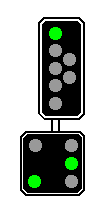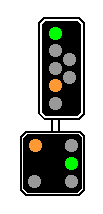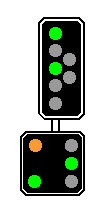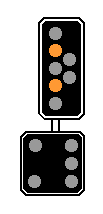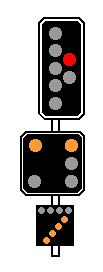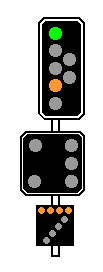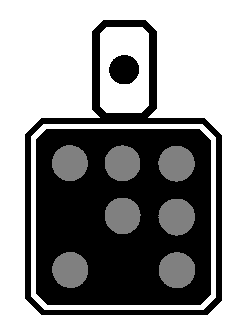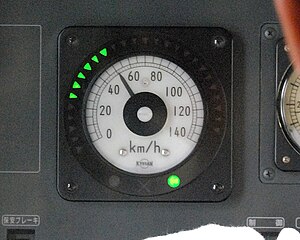Railway Signals in Goyanes: Difference between revisions
20agoyanes (talk | contribs) m (→AVK System) |
20agoyanes (talk | contribs) (changing to Swiss system) |
||
| Line 5: | Line 5: | ||
|} | |} | ||
Railway signals in [[Goyanes]] evolved from electro-mechanical semaphores that changed position to indicate track block status. Before then though, railways employed “track officers” to manage sections of track using hand gestures, line-of-sight techniques, and physical tokens that had to be passed from train to officer and vice versa. This was wildly inefficient, and as the railways grew, technologies were developed to reduce collisions and improve railway safety. Starting with the Grand Trunk Railway and spreading quickly around the nation, electric track circuits that controlled semaphore signals began to take hold. The process started in the 1870s, but by the 1890s, Goyanes’ railway network was fully | Railway signals in [[Goyanes]] evolved from electro-mechanical semaphores that changed position to indicate track block status. Before then though, railways employed “track officers” to manage sections of track using hand gestures, line-of-sight techniques, and physical tokens that had to be passed from train to officer and vice versa. This was wildly inefficient, and as the railways grew, technologies were developed to reduce collisions and improve railway safety. Starting with the Grand Trunk Railway and spreading quickly around the nation, electric track circuits that controlled semaphore signals began to take hold. The process started in the 1870s, but by the 1890s, Goyanes’ railway network was fully electro-mechanically signaled. | ||
In 1902, the Stortoghass Tunnel Crash in Gojannesstad occurred, where a trough train engineer running a service from the Hysende-Osanhalt-Kongsland Railway onto the grand trunk in Gojannesstad became confused by the Grand Trunk's signal system, and crashed the train, resulting in 30 deaths and more than 50 injuries. This caused the Ministry of Transportation (then known as the Ministry of Railways) to mandate a new, unified, national signal system. The new signal system became known as M-Class signals (''M-klassesignalen''). M-Class signals used semaphores and relays, and a unified set of meanings. This helped promote inter-operation, and created a stanrdized and safer working environment for the railways. | |||
By the early 1930s, the Ministry of Railways had consolidated all of Goyanes' railways into four companies, the Grand Trunk, the Hysende-Osanhalt-Kongsland, the Nordstrom Seabord, and the Hirendag Road. As part of this consolidation effort, a new signalling system based on color-light aspects was introduced. This became known as the L-Class signals (''L-klassesignalen''). The L-Class also introduced a new safety system known as ATS-M. ATS-M uses electromagnetic induction to warn the driver that they have passed a cautionary aspect, and stop the train if a signal has been passed at danger. The ATS-M system, in addition to L-Class signals are still used on all classic lines today. | |||
The devolopment of the HHT system in the 1960s and 1970s forced Gojan Jårnbaner, Goyanes' state railway operator, to develop a cab signalling system. The high speeds of the HHT system prevented operators from being able to see and comprehend any trackside signals, so a system that transmits speed and track information directly to the driver was created, known as AVK. AVK is currently on its second iteration. In addition, a new system known as HBK that uses train-mounted microprocessors and track-mounted beacons to enforce speed limits set by both track conditions and signal state. HBK is installed on all classic lines in Goyanes. | |||
In the 1990s, in an effort to modernize and increase frequency on Goyanes' classic lines, AVK was installed on certain classic lines to increase frequency. In additon, a new signalling system that was able to understand and adapt to the abilities of more modern rail equipment (high speed switching points and quicker braking curves on trains). This system became known as the A-Class signals (''A-Klassesignalen''). | |||
Currently in Goyanes, all signals are either L- or A-Class, all classic lines and trains are equipped with HBK, and high-speed trains and lines are equipped with AVK. The introduction of A-Class signals did not completely phase out L-Class signals, and retrofitting is done on a per-line basis, with higher-throughput lines getting switched over first, and lesser used primary and secondary lines later. About half of the classic network still uses L-Class signals. | |||
== L-Class Signals == | |||
Signals in Goyanes are based on the distant-main block system. Distant signals (Vørsignalen) alert the driver to the aspect of the next main signal (Hovedsignalen), so that the driver may act accordingly in time for the main signal. Both L- and A- type signals may be used for main line traffic up to 160 km/h. Above 160 km/h national regulations require the use of cab signalling. | |||
Main signals (Hovedsignalen) are called so because they can display a stop aspect. If the stop aspect shows, it may not be passed without authorization, and is therefore considered a very important point in the track layout. Therefore, they earned the name "main signal." A main signal can be recognized by its rectangular shape. They may contain either one or two vertical rows of lights, however they will always be taller than they are wide. | |||
Main signals are used at several places along the lines. They are used at the entrances to stations, at which point they are called "home signals" (''Hussignalen''), at the exits of stations, where they are called "exit signals" (''Utgangsignalen''), so break the track signals into blocks, and to guard interlockings. For the latter two they are simply known as main signals. After the introduction of the A-Class signals in 1990, certain changes were made to the L-Class for safety purposes. First, home signals will display a board over the signalhead with the letters "HUS" on them, and some signals protecting interlockings were retrofitted with a board depicting a white diamond on a black background. | |||
Distant signals (Vørsignalen) announce to the driver what will be shown to the driver at the next main signal, thus their name. A distant signal cannot stop a train, but they can slow one down in time for a stop signal or a diverging set of switch points. Distant signals are always square-shaped. For there to be a distant signal, there must either be a main signal or an end of track. However, you do not need a distant signal attached to a main signal. For any tracks (always secondary lines) where the speed limit is less than 40 km/h or of the railway uses cogs in the center of the track (alpine routes), the use of distant signals is optional, however once the track speed is above 40 km/h, use of distant signals is mandatory. | |||
Distant signals can be mounted allong with a main signal on the same mast. The distant signal must be mounted below the main signal on the mast. Distant signals are only mounted on the main signal if the next block is 1200 meters or less. If it is more than 1200 meters, there will be a separate distant signal before the main signal it protects. | |||
The following graphics show main signals with the distant signals that announce them mounted below. In most circumstances the next signal aspect displayed by the distant signal would be different. In addition, the main signals shown have the capability of displaying all aspects. In most circumstances, main signals can only display certain aspects that relate to the condition of the lines they protect, and as such could have as few as three or four lamps, instead of the seven pictured here. Regardless, the light and color combinations carry the meaning, not the total amount of bulbs on the signalhead. | |||
{| class="wikitable" | {| class="wikitable" | ||
|- | |- | ||
! | ! Aspect !! Meaning | ||
|- | |||
| [[File:Signal-Halt.gif]] || '''Stop'''<br/>All trains must stop before the signal, or they risk tripping the ATS-M system and forcing an emergency stop. The signal may only be passed after permission from the dispatcher is given.<br/>The distant signal is placed at a safe braking distance from the main signal it protects. The distant signal indicates that the should expect the next main signal to display a stop aspect. Sometimes when a Stop signal is displayed and a distant signal is mounted under the main signal, the distant signal's lights may be shut off. This does not affect the meaning of the main signal. | |||
|- | |||
| [[File:Signal-FB1.gif]] || '''Clear'''<br/>The train may pass at the maximum permitted speed, either by trackside signs or the timetable, whichever is slower.<br/>The distant signal indicates that the should expect the next main signal to display a clear aspect.<br/>On switchpoints that can be passed at track speed, even if the signal displays clear, this aspect may apply for a diverging route. | |||
|- | |- | ||
| [[ | | [[File:Signal-FB2.gif]] || '''Caution 40'''<br/>The track is clear, but the train may travel no more than 40 km/h after the first axle of the train passes the main signal. This signal may be used to enforce a braking curve on heavier trains or to govern a switchpoint that has a 40 km/h limit. If the timetable or posted speed is slower, it must be followed instead.<br/>The distant signal indicates that the main signal is showing a caution 40 aspect, and the driver should begin braking so that the train passes the main signal at 40 km/h or slower. This distant signal may also indicate that the next signal is displaying the "Short Block" or "Proceed Occupied Block" aspects, and that the driver should slow down to 40 km/h or less before passing the next signal. | ||
| | |||
|- | |- | ||
| [[ | | [[File:Signal-FB3.gif]] || '''Caution 60'''<br/>The track is clear, but the train may travel no more than 60 km/h after the first axle of the train passes the main signal. This signal may be used to enforce a braking curve on heavier trains or to govern a switchpoint that has a 60 km/h limit. If the timetable or posted speed is slower, it must be followed instead.<br/>The distant signal indicates that the main signal is showing a caution 60 aspect, and the driver should begin braking so that the train passes the main signal at 60 km/h or slower. | ||
|- | |- | ||
| [[ | | [[File:Signal-FB5.gif]] || '''Caution 90'''<br/>The track is clear, but the train may travel no more than 90 km/h after the first axle of the train passes the main signal. This signal may be used to enforce a braking curve on heavier trains or to govern a switchpoint that has a 90 km/h limit. If the timetable or posted speed is slower, it must be followed instead.<br/>The distant signal indicates that the main signal is showing a caution 90 aspect, and the driver should begin braking so that the train passes the main signal at 90 km/h or slower. | ||
|- | |- | ||
| [[File:Signal-FB6.gif]] || '''Short Block'''<br/>The track is clear, and the next signal is displaying stop, but is unusually close. Any distant signal at a main signal displaying "Short Block" is shut off. Due to the abnormally short block, there is no adequate braking curve and the train must proceed at no less than 40 km/h.<br/>This signal usually protects tub platforms at stations, as there is no safe braking distance. | |||
| | |||
|- | |- | ||
| [[File:Signal-Hilfe.gif]] || '''Restricted'''<br/>The track status is unknown, and the signal is displaying this aspect potentially due to a defect or other condition. The train may proceed at a maximum of 30 km/h or whatever lower speed the driver wishes. The train must be able to stop for any obstructions.<br/>The indicator below the distant signal allows the stop aspect to become permissive, as it is diagonal. If the indicator was showing a horizontal aspect, this would be considered a standard stop aspect. | |||
| | |||
|- | |- | ||
| [[File:Signal-L-Bes.gif]] || '''Proceed Occupied Block'''<br/>The block is occupied by another train. The train must proceed at 40 km/h or less, and follow the authority of trackside personnel to stop short of, or couple to another train.<br/>Sometimes when a train needs to be coupled, and this aspect is not available, dispatch may order a train to proceed through a stop signal. | |||
| | |||
|- | |- | ||
| [[ | | [[File:Kombisig-Typ-L.gif]] || '''K-System Stop'''<br/>On certain distant signals that are freestanding, a small white sign with a black dot may be placed above the signalhead. This indicates that if the signal is shut off, the aspect means stop.<b/>On lighted signals displaying this aspect, the board on top means that the distant signal could be treated as a main signal. K-System is only used where there are lower speed limits and very short blocks. For turnouts at switchpoints, the newer speed limit becomes enforced at the 2nd instance of the caution speed signal. | ||
|} | |} | ||
=== | == A-Class Signals == | ||
By the end of the 20th century, it became apparent that Goyanes' L-Class signalling system was not adequate for modern rail travel. The braking curves that were integrated into the system were designed for steam and early electric locomotives that took much longer to brake and accelerate. In addition, railway technology had advanced, and by now, switchpoints had been constructed with the ability for high-speed transit, making the previous aspects useless in some areas. | |||
Regarding braking curves, by 1980 there were 160 km/h trains in operation on classic lines. With the next possible speed downgrade on the L-Class system being to 90 km/h, it represented a waste of time to slow trains down to 90 km/h to transit a switch that coupld have been passed at 120 km/h. Upgrading the L-Class system with more aspects would have made the system more complicated and difficult to understand, so Gojan Jårnbaner decided to design a new signalling system for the future of the network. | |||
The new requirements of the system were more fine-tuned braking curves, and an easier to understand color-light system for the drivers. The previous L-Class had been based on mechanical semaphores, and training was easy when drivers already understood the semaphores. However, now that they were gone, the system became increasingly more complex to explain. As a result a much simpler system had to be developed. | |||
The new system that was developed was easily integrable into the L-Class network, and used principles of the K-System, where distant and main signals were combined on certain signals, which was already familiar to drivers. The system was designed by engineers, and used high-school students as a control group in addition to drivers to ensure that the system was easy enough for novice drivers to understand, while still maintaining all the needed design features. | |||
As all A-Class signals can display both a distant and a main signal aspect, several changes had to be made. The first, signals that had no ability to display stop using a light have square borders. The second, signals protecting station entrances (home signals) display a board that says "HUS" over the signalhead to indicate it is a home signal. Third, signals protecting interlockings have a board over the signalhead that shows a white diamond over a black background. The latter two have been incorporated into the L-Class signals. | |||
Similarly to the L-Class signals, if a block section is more than 1200 meters, there will be a separate distant signal that uses a square signalhead before the main signal. Otherwise, standard round signalheads can represent upcoming changes in the signal state. | |||
{| class="wikitable" | {| class="wikitable" | ||
|- | |- | ||
! | ! Distant Signal !! Main Signal !! Meaning | ||
! Meaning | |- | ||
| [[File:Sign suisse N avance ouvert.GIF]] [[File:Sign suisse N principal ouvert.GIF]] || [[File:Sign suisse N principal ouvert.GIF]] || '''Clear'''<br/>The train may pass at the maximum permitted speed, either by trackside signs or the timetable, whichever is slower. The nature of the A-Class signal means that the next signal will also be displaying a clear aspect. | |||
|- | |||
| Example || Example || Example | |||
|- | |||
| Example || Example || Example | |||
|- | |- | ||
| | | Example || Example || Example | ||
| | |||
|- | |- | ||
| | | Example || Example || Example | ||
| | |||
|- | |- | ||
| Example || Example || Example | |||
|- | |- | ||
| | | Example || Example || Example | ||
| | |||
|} | |} | ||
== Shunting/Dwarf Signals == | == Shunting/Dwarf Signals == | ||
Revision as of 01:37, 10 April 2020
This article is incomplete because it is pending further input from participants, or it is a work-in-progress by one author. Please comment on this article's talk page to share your input, comments and questions. Note: To contribute to this article, you may need to seek help from the author(s) of this page. |
| This article is in work in progress. Any information here may not be final as changes are often made to make way for improvements or expansion of lore-wise information about Goyanes. Please do not edit anything here without the consent of the article's creator. The article's creator is Goyanes (alternate: 20agoyanes). |
Railway signals in Goyanes evolved from electro-mechanical semaphores that changed position to indicate track block status. Before then though, railways employed “track officers” to manage sections of track using hand gestures, line-of-sight techniques, and physical tokens that had to be passed from train to officer and vice versa. This was wildly inefficient, and as the railways grew, technologies were developed to reduce collisions and improve railway safety. Starting with the Grand Trunk Railway and spreading quickly around the nation, electric track circuits that controlled semaphore signals began to take hold. The process started in the 1870s, but by the 1890s, Goyanes’ railway network was fully electro-mechanically signaled.
In 1902, the Stortoghass Tunnel Crash in Gojannesstad occurred, where a trough train engineer running a service from the Hysende-Osanhalt-Kongsland Railway onto the grand trunk in Gojannesstad became confused by the Grand Trunk's signal system, and crashed the train, resulting in 30 deaths and more than 50 injuries. This caused the Ministry of Transportation (then known as the Ministry of Railways) to mandate a new, unified, national signal system. The new signal system became known as M-Class signals (M-klassesignalen). M-Class signals used semaphores and relays, and a unified set of meanings. This helped promote inter-operation, and created a stanrdized and safer working environment for the railways.
By the early 1930s, the Ministry of Railways had consolidated all of Goyanes' railways into four companies, the Grand Trunk, the Hysende-Osanhalt-Kongsland, the Nordstrom Seabord, and the Hirendag Road. As part of this consolidation effort, a new signalling system based on color-light aspects was introduced. This became known as the L-Class signals (L-klassesignalen). The L-Class also introduced a new safety system known as ATS-M. ATS-M uses electromagnetic induction to warn the driver that they have passed a cautionary aspect, and stop the train if a signal has been passed at danger. The ATS-M system, in addition to L-Class signals are still used on all classic lines today.
The devolopment of the HHT system in the 1960s and 1970s forced Gojan Jårnbaner, Goyanes' state railway operator, to develop a cab signalling system. The high speeds of the HHT system prevented operators from being able to see and comprehend any trackside signals, so a system that transmits speed and track information directly to the driver was created, known as AVK. AVK is currently on its second iteration. In addition, a new system known as HBK that uses train-mounted microprocessors and track-mounted beacons to enforce speed limits set by both track conditions and signal state. HBK is installed on all classic lines in Goyanes.
In the 1990s, in an effort to modernize and increase frequency on Goyanes' classic lines, AVK was installed on certain classic lines to increase frequency. In additon, a new signalling system that was able to understand and adapt to the abilities of more modern rail equipment (high speed switching points and quicker braking curves on trains). This system became known as the A-Class signals (A-Klassesignalen).
Currently in Goyanes, all signals are either L- or A-Class, all classic lines and trains are equipped with HBK, and high-speed trains and lines are equipped with AVK. The introduction of A-Class signals did not completely phase out L-Class signals, and retrofitting is done on a per-line basis, with higher-throughput lines getting switched over first, and lesser used primary and secondary lines later. About half of the classic network still uses L-Class signals.
L-Class Signals
Signals in Goyanes are based on the distant-main block system. Distant signals (Vørsignalen) alert the driver to the aspect of the next main signal (Hovedsignalen), so that the driver may act accordingly in time for the main signal. Both L- and A- type signals may be used for main line traffic up to 160 km/h. Above 160 km/h national regulations require the use of cab signalling.
Main signals (Hovedsignalen) are called so because they can display a stop aspect. If the stop aspect shows, it may not be passed without authorization, and is therefore considered a very important point in the track layout. Therefore, they earned the name "main signal." A main signal can be recognized by its rectangular shape. They may contain either one or two vertical rows of lights, however they will always be taller than they are wide.
Main signals are used at several places along the lines. They are used at the entrances to stations, at which point they are called "home signals" (Hussignalen), at the exits of stations, where they are called "exit signals" (Utgangsignalen), so break the track signals into blocks, and to guard interlockings. For the latter two they are simply known as main signals. After the introduction of the A-Class signals in 1990, certain changes were made to the L-Class for safety purposes. First, home signals will display a board over the signalhead with the letters "HUS" on them, and some signals protecting interlockings were retrofitted with a board depicting a white diamond on a black background.
Distant signals (Vørsignalen) announce to the driver what will be shown to the driver at the next main signal, thus their name. A distant signal cannot stop a train, but they can slow one down in time for a stop signal or a diverging set of switch points. Distant signals are always square-shaped. For there to be a distant signal, there must either be a main signal or an end of track. However, you do not need a distant signal attached to a main signal. For any tracks (always secondary lines) where the speed limit is less than 40 km/h or of the railway uses cogs in the center of the track (alpine routes), the use of distant signals is optional, however once the track speed is above 40 km/h, use of distant signals is mandatory.
Distant signals can be mounted allong with a main signal on the same mast. The distant signal must be mounted below the main signal on the mast. Distant signals are only mounted on the main signal if the next block is 1200 meters or less. If it is more than 1200 meters, there will be a separate distant signal before the main signal it protects.
The following graphics show main signals with the distant signals that announce them mounted below. In most circumstances the next signal aspect displayed by the distant signal would be different. In addition, the main signals shown have the capability of displaying all aspects. In most circumstances, main signals can only display certain aspects that relate to the condition of the lines they protect, and as such could have as few as three or four lamps, instead of the seven pictured here. Regardless, the light and color combinations carry the meaning, not the total amount of bulbs on the signalhead.
A-Class Signals
By the end of the 20th century, it became apparent that Goyanes' L-Class signalling system was not adequate for modern rail travel. The braking curves that were integrated into the system were designed for steam and early electric locomotives that took much longer to brake and accelerate. In addition, railway technology had advanced, and by now, switchpoints had been constructed with the ability for high-speed transit, making the previous aspects useless in some areas.
Regarding braking curves, by 1980 there were 160 km/h trains in operation on classic lines. With the next possible speed downgrade on the L-Class system being to 90 km/h, it represented a waste of time to slow trains down to 90 km/h to transit a switch that coupld have been passed at 120 km/h. Upgrading the L-Class system with more aspects would have made the system more complicated and difficult to understand, so Gojan Jårnbaner decided to design a new signalling system for the future of the network.
The new requirements of the system were more fine-tuned braking curves, and an easier to understand color-light system for the drivers. The previous L-Class had been based on mechanical semaphores, and training was easy when drivers already understood the semaphores. However, now that they were gone, the system became increasingly more complex to explain. As a result a much simpler system had to be developed.
The new system that was developed was easily integrable into the L-Class network, and used principles of the K-System, where distant and main signals were combined on certain signals, which was already familiar to drivers. The system was designed by engineers, and used high-school students as a control group in addition to drivers to ensure that the system was easy enough for novice drivers to understand, while still maintaining all the needed design features.
As all A-Class signals can display both a distant and a main signal aspect, several changes had to be made. The first, signals that had no ability to display stop using a light have square borders. The second, signals protecting station entrances (home signals) display a board that says "HUS" over the signalhead to indicate it is a home signal. Third, signals protecting interlockings have a board over the signalhead that shows a white diamond over a black background. The latter two have been incorporated into the L-Class signals.
Similarly to the L-Class signals, if a block section is more than 1200 meters, there will be a separate distant signal that uses a square signalhead before the main signal. Otherwise, standard round signalheads can represent upcoming changes in the signal state.
Shunting/Dwarf Signals
Shunting signals, also known as “dwarf signals” (kleinesignalen), are used for shunting purposes in yards, as well as for allowing permittivity of signals at danger such as at entrances to train station platforms to allow shunting or coupling of trains. They are smaller in size, and use only white aspect colors. They may be placed on top of a half-height post, or placed at the same height as the roadbed.
There are also types of dwarf signals, called "Main Dwarf signals" (Hovedkleinsignalen) used as stand-ins for home signals in stations with a lot of shunting operations or where there are a lot of switches that need protection. In addition to the dwarf signal aspects given below, these signals also have a red light and may have two green ones (one for Caution 50, the other for Proceed 100).
Railroad Crossing Status (RCS) Signals
RCS signals (Vagersignalen or VS) are used to indicate to the driver the status of a railroad crossing ahead on the line. Various factors affect the aspect displayed. The most simple kinds simply confer if the gates are closed and locked, but the most advanced types rely on sensors that can detect if vehicles are stalled on the crossing, in addition to detecting whether or not they have been locked. There are two types of RCS signals, just like color-lights, they are Main Signals and Distant Signals. Main RCS signals are identified by a “V” sign under the bulbs. Distant RCS signals are identified by their shape and unique bulb layout.
A related signal called a Bridge Status Signal (Bryggesignalen or BS) uses the same signalheads and aspects, except the main BSS signals have a "B" signpost under the signal head, similar to how main RCS signals have a "V" signal on them.
Main RCS Signals (Hovedvagersignalen/HVS)
Distant RCS Signals (Vørvagersignalen/VVS)
AVK System
The AVK system was invented in 1922 after a Ministry of Transportation commission ruled that the consolidated four railways (Grand Trunk RR, Hysende-Osanhalt-Kongsland RR, The Hirendag Road, Nordstrom Seaboard RR) must install an automatic train stop technology on all trains if they wish to run above 100 km/h. The four railways convened to develop the technology, which was first tested in 1923. They came to the conclusion that not only could they stop the train, they could govern speeds using the cab displays. The way it functioned was by using track currents at either 100 Hz or 91.6 Hz (to avoid electrical interference on 3rd rail lines) to convey pulsating codes to a receiver mounted on the front of the train. The original AVK system used 4 codes, resulting in four basic speeds. They were “posted track speed,” 70 km/h, 50 km/h, and 30 km/h. This first edition was known as AVK-1, and was installed around the country to comply with the new regulations. The AVK system was updated with more codes to remove posted track speeds, and convey all speed information electronically, as well as integrating adaptive speed control into the mix. These iterations were known as AVK-2 and AVK-3.
How modern AVK (AVK-2, -3, -4H, -5H, and -6H) regulates the train is as follows: when the onboard computer receives the track code, the monitor inside the cab will show the new speed readout. On older systems, it would illuminate a bulb corresponding to the readout, on later systems it appears on a digital display. The computer, upon receiving the code, checks the train's speed against the new speed. If the speed is in violation, a warning tone sounds, and initiates a grace period. If braking does not commence in the grace period, the train applies a penalty brake automatically to bring the train into compliance. If the overspeed persists, the emergency brakes are applied. In this regards, AVK is an Automatic Train Control (ATC) system.
In contrast, on AVK-1, there was no speed control, rather it was an advanced form of automatic train stop. If there was a change in restriction, whether positive or negative, the AVK would sound a tone, and if the driver did not acknowledge in a certain timeframe, the emergency brakes were applied.
In the 1960s as the Høyhastikettog (HHT) high-speed trains were being developed, a new AVK generation was devised to create common functionality and safety. This was known as AVK-4H, the H standing for HHT. The system relies on overlay pulse codes at 250 Hz current, which augment the existing 100/91.6 Hz codes to create even more code availability. AVK-4H was installed on most lines and trains by the 1970s. -4H accepts external inputs such as train weight and performance that onboard computers could use to calculate braking curves for the signal speed readouts it provided.
In 1985, with the widespread adoption of digital computing, AVK-5H was introduced. AVK-5H uses computer stations both lineside and aboard the train to take into account more factors such as braking gradients, train set performance, track geometry, and more to more accurately adjust speeds for trains. In addition AVK-5H and -4H pulse codes remained the same, it was more an upgrade to the computing infrastructure both on the train and lineside. The advent of computing aboard the train in -5H makes a smoother ride possible, as the train does not have to continue unneccessarily braking and coasting over and over again, as it did with the -4H system.
In recent years, AVK-6H has been developed for use on the HHT system. As speeds increased to 360 km/h, new pulse codes were developed in both the 100/91.6 Hz range and in the 250 Hz range to allow even higher speeds. So far, AVK-6H is only installed on HHT trains capable of >320 km/h and on tracks capable of such speeds. It has full backwards compatibility with -5H to ensure interoperability.
Currently, AVK-4H, -5H and -6H are the most common systems of AVK in use, however usage of -4H is limited to conventional lines, while -5H and -6H are found on high-speed lines, and several dedicated lines. It is installed on most passenger trains in the GJ system, but many freight trains do not have it, and instead rely on the color-light signal aspects for speed regulation.
AVK is failsafe at all generations, as the absence of a pulse code gives a 30 km/h speed limit readout. On lines without AVK, the system can be overridden. The system remains on in a standby state though, and at the first detection of new code, will activate again. Track codes that exceed a train's design speed are nulled out to the highest possible speed for the train by the onboard AVK reciever to ensure safe operation.
AVK Pulse Codes
| 100/91.6 Hz code | 250 Hz code | Cab Signal Speed | Notes |
|---|---|---|---|
| 0 | 0 | 30 km/h | Original AVK Code. Failsafe State. |
| 75 | 0 | 50 km/h | Original AVK Code. |
| 75 | 75 | 70 km/h | Original AVK Code. Remapped starting with AVK-4H. |
| 96 | 0 | 100 km/h | Original AVK Code, "Posted Speed." Valued at 100 with AVK-2. |
| 96 | 96 | 130 km/h | Introduced on AVK-2, Remapped with AVK-4H. |
| 120 | 0 | 160 km/h | Introduced on AVK-2, Remapped with AVK-4H. |
| 120 | 120 | 200 km/h | Introduced on AVK-3, Remapped with AVK-4H. |
| 180 | 0 | 240 km/h | Introduced on AVK-4H. |
| 180 | 180 | 270 km/h | Introduced on AVK-4H. |
| 270 | 0 | 280 | Introduced on AVK-5H. |
| 270 | 270 | 300 km/h | Introduced on AVK-5H |
| 420 | 0 | 320 km/h | Introduced on AVK-6H |
| 420 | 420 | 360 km/h | Introduced on AVK-6H. |
Automatic Train Stop (ATS)
Automatic Train Stop (Automatisk Togstanna/ATS) is a system that governs color-light signals that are in danger. The current ATS system (ATS-M) was invented at the same time as AVK-4H to protect lines that would use only the normal signal system. Previous ATS systems relied on mechanical infrastructure, such as tripcocks opening brake valves when a signal was passed at danger. Such systems still exist on select railways, such as the Gojannesstad U-Baner, among others. However, on the GJ network, the ATS-M system is operational. It functions on a permanent magnet placed at the center of the track at the end of the safety overlap, several meters past the signal, with an electromagnet placed immediately afterwards in the direction of travel (placed on both sides in omnidirectional lines). When the signal is at danger, the electromagnet shuts off. As the train passes over the magnet, a sensor is tripped by the permanent magnet, and a grace period of about 2 seconds activates. After the expiration, the ATS system sounds a warning alarm, shuts off power and activates the emergency brake.
However, when the signal is clear, the electromagnet turns on (a failsafe, if power is cut to the electromagnet the train is stopped). When the train passes over the permanent magnet, the grace period activates, however the electromagnet untrips the sensor on the train, switching off the ATS system, and sounding a chime in the cab. This allows for positive feedback to remind the driver they have passed a clear or caution signal, and are OK. The system can be either uni- or bi-directional. Bi-directionality is achieved by installing the electromagnet on both sides of the permanent magnet, allowing both directions to use it properly. On uni-direction track, the ATS magnet may be mistakenly tripped by trains going the opposite direction with authorization. In such cases a signboard is shown to override the ATS system.
The ATS-M system may be overridden (in case of a shunting signal allowing access) by holding down the override button as the train passes over the magnet. Mechanical ATS systems such as on the U-Baner cannot be overridden except by dispatch due to the nature of the system.
Driver Reminding Apparatus (DRA)
The DRA (Førermann Påminnelsemasjin/FPM) is a memory device used as an extra safety net aboard trains. Its use was mandated after the 1995 Ragnarfjord Train Crash, in which 30 people died because a driver passed a signal at danger after stopping within the safety overlap at a station platform (the signal head was not visible from the cab).
The DRA functions as a kill switch for traction on the train. It is a two-position switch, on and off. When the DRA is set, traction power is disconnected for the train. Railway regulations stipulate that the DRA must be set when shutting a train off, entering or exiting the cab, when the train has stopped for a signal at danger. The DRA may only be turned off when the train has authority to proceed (i.e. the signal clears), the driver has authority to turn on the train, or when the driver has been granted authority to pass a signal at danger by a shunting signal or by radio orders from dispatch.


